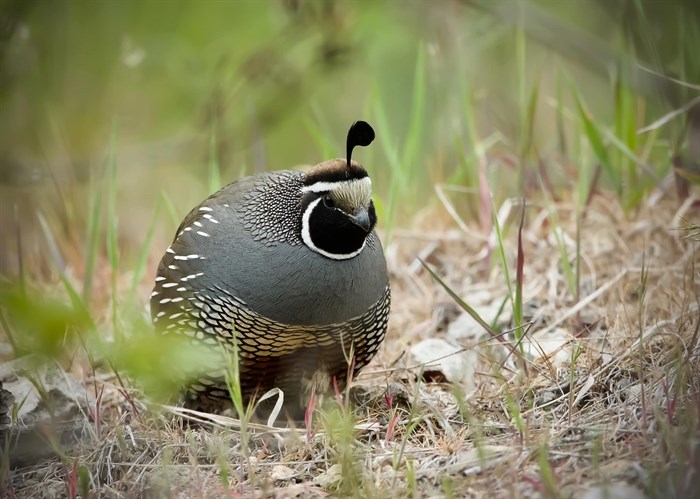
Image Credit: SUBMITTED/ Danny Coyne
June 07, 2020 - 8:00 AM
A popular Okanagan bird, the California quail, can often be seen traipsing through neighbourhoods, recognizable by its classic blue coat and topknot that makes it look almost comical.
But the bird isn’t from the Okanagan, and some birdwatchers believe it may be expanding its territory northwards, to the Shuswap and Kamloops area.
The California quail is native to the southwestern U.S. but introduced as a game bird in other parts of the world including British Columbia. In Canada, its range is confined largely to the Okanagan where the locals are often surprised to find out the quail isn't a native species, but introduced into the province in the 19th century.
READ MORE: Everything you need to know about quail in the Southern Interior
They are technically an invasive species, first introduced in the Victoria area in 1860 and then in the Lower Mainland about 20 years later. Quail were introduced in Nicola in the Interior in the 1890s but seem to have made their way into the Okanagan from an introduction into Northern Washington.
The Okanagan introduction has been the most successful by far.
Rick Howie, a biologist in Kamloops and member of Kamloops Naturalist Club, thinks the California quail may be expanding northwards from the Okanagan, pushing the outer boundaries of its territory. He’s heard reports of them in Westwold, and in the Shuswap near Squilax and in the Thompson Nicola region. There have also been a few reports of them in Kamloops.
Milder winters in Kamloops may make it easier for them to survive, he said. They’re also good reproducers, he said.
“We might start getting more and more reports (in the Thompson Nicola),” he said, but it depends on the climate. Colder winters could make it harder for California quail to establish themselves. To move to neighbouring communities, the quail would need to establish a good breeding population in order to survive, he said.
Chris Charlesworth, a birdwatcher and owner of Avocet Tours, said he was surprised to see California quail at higher elevations when they're normally commonly found closer to the Okanagan Valley bottom.
The California quail likes shrubbier areas, like in Westwold, Howie said.
The highly social quail form large family groups or coveys of 20 or more and can frequently be seen moving as a flock across open or grassy ground. The male is boldly patterned, with a dark brown cap, black face and throat, a chestnut patch on the belly with a bluish grey breast and speckled flanks with white stripes on the forehead and around the neckline. Females are more muted in colour, mostly grey-brown with a light coloured belly.
Both genders have the comma-shaped head plume that arches forward over their faces, although the female's plume is much smaller. They can grow to about 24 to 28 centimetres long.
This story originally had that the chukar is a white quail in Kamloops, which is incorrect. It is a partridge. The story has been updated June 10 to remove a comment from Howie that regarding the chukar.
To contact a reporter for this story, email Carli Berry or call 250-864-7494 or email the editor. You can also submit photos, videos or news tips to the newsroom and be entered to win a monthly prize draw.
We welcome your comments and opinions on our stories but play nice. We won't censor or delete comments unless they contain off-topic statements or links, unnecessary vulgarity, false facts, spam or obviously fake profiles. If you have any concerns about what you see in comments, email the editor in the link above.
News from © iNFOnews, 2020